| |
|
 |
|
This pleasant little church
sits out on the edge of a straggle of
suburbia to the south of Bury St Edmunds,
Great Whelnetham running into
Sicklesmere, which gives its name to the
ancient Hundred, but has no parish church
of its own. The church is entirely in the
Essex style, although we are still a good
ten miles from the border here. The
churchyard is secluded, setback behind
the village school, a green velvet bed
for a jewel of a church on the morning in
late summer 2014 that I most recently
visited. Sam Mortlock found it
depressing on his visit in the 1980s, but
the grim pebbledash he mentions has been
repainted on the nave at least, and it
presents a pretty prospect to the south.
There probably never was a tower,
although a 15th century bequest left
money for one. In any case, evidence
remains of the Norman, and possibly
Saxon, origin of this church. The little
clerestory is delightful, like the
windows in the upper storey of a cottage.
As
so often with churches of this kind, St
Thomas of Canterbury seems larger inside
than out, a feeling enhanced by the lack
of clutter and the bright light inside.
The chancel has been cleared of
furnishings, a north transept neatly
arranged with modern chairs. The transept
was added in 1839, an early date and
suggesting it was built for increased
capacity rather than liturgical reasons.
Its domestic window tracery and small
chimney add to the sense of this being a
cottage as much as a church. A tapestry
of the Annunciation hangs in the
transept, and generally there is an air
of simplicity about the nave and its
transept. A lot happened here in the 19th
and 20th Centuries, but stil the Norman
lancets remain to remind us of how long
this serious house has been here.
Everything is well looked after and
obviously loved.
|
It
is obvious too that this church had
Anglo-catholic sympathies early in the 20th
Century, and surviving evidence includes the
rather extraordinary east window. It is by
Burlison & Grylls, and forms the parish war
memorial. From left to right, it depicts the boy
David, St George, St Nicholas and Joan of Arc, an
eclectic mix to find in an English country parish
church, especially Joan of Arc who is rarely
depicted in Anglican churches (although, quite by
coincidence, I came across another representation
of her later in the week at St Sepulchre on
London's Holborn Viaduct). Scenes in the story of
each are under their feet.
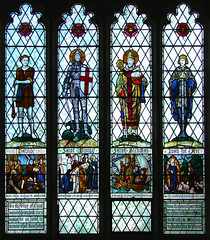  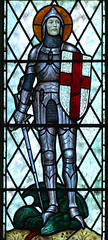 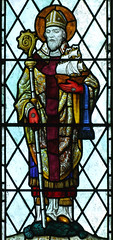 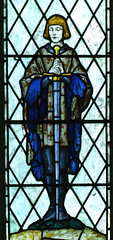
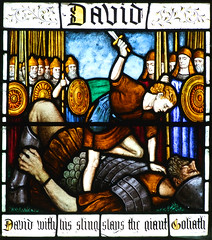 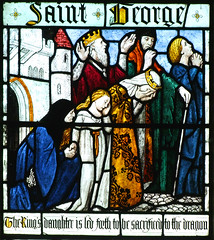  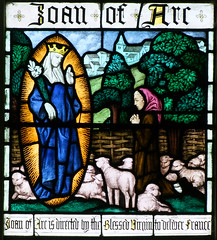
Fragments
of medieval glass survive, and the most haunting
is a fragment of a 15th Century nativity scene.
An angel peeps in awe over the stable wall at the
new born baby Jesus lying in the manger. But the
angel is all that survives. But perhaps the most
fascinating glass here is that reset in the south
windows of the sanctuary. This is a part of
Suffolk with plenty of surviving medieval glass,
so you might at first not give these fragments a
second look. But they are worth careful study
because among them are several birds holding
banners reading 'Jesu Mercy' and 'Jesu Help'.
These must come right at the end of the medieval
period, when liturgical devotion begins to be
expressed in English rather than Latin. You often
come across devotional inscriptions in English at
the end of the late Medieval period on brasses,
screens and the like, but on glass the only other
ones in East Anglia that I can think of are at
Leverington in Cambridgeshire. But those are not
prayer clauses, and far as I know these prayer
clauses written in medieval English are unique
survivals in English glass.
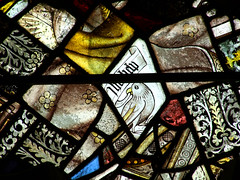 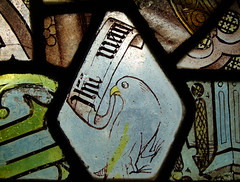 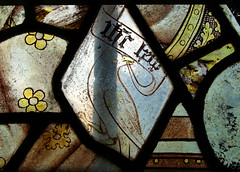
There
are a couple of interesting memorials. The best
is to Charles and Elizabeth Battely, who died in
the early 18th Century, and their memorial is a
vast stone drape behind a tomb which looks rather
alarmingly as if it might be made out of corned
beef. The inscription mentions that it was placed
their by their daughter Jane Merest, hastening to
add that Jane's husband James had been Clerk
Assistant of the House of Lords.
The
church seems to be open every day from Easter to
September, with a keyholder at other times. On
one occasion I tipped up here on a Saturday in
early Spring only to find all three keyholders
out. Heading back to the church to photograph the
outside, I met an old local in the churchyard who
asked me if I wanted to see inside. I explained
that I'd already tried the keyholders, to which
he replied 'don't you worry about that', and gave me another address to
try (something along the lines of "I think
it's the third house along, or possibly the
fourth, just bang on the door, open it and shout
for Val, if she's not in the key's in the kitchen
drawer" or something) but being metropolitan
and not used to such country ways, I demured.
Great
Whelnetham was home to one of the last abuses of
pluralism in Suffolk in the 19th Century. In
1816, during the last years of the lengthy reign
of King George III, a young man called Henry
George Phillips was installed as the Rector here,
for which he would earn £375 a year. Two years
later, he was further installed as the Rector of
the vast parish of Mildenhall, a poor industrial
town 20 miles off, and Suffolk's biggest parish.
His Mildenhall rectorship brought him a further
£450 a year, the combined total of £825 being
worth about £160,000 annually in today's money.
Not unnaturally he preferred to live at Great
Whelnetham, and he employed poorly paid curates
to carry out the liturgical, pastoral and
administrative work at Mildenhall. He started
with some energy - the construction of the north
transept here at Whelnetham was under his
rectorship - but as the years passed he seems to
have preferred the life of a country gentleman.
| Over the next few decades,
the rise of the Oxford Movement would
transform the Church of England and do
away with such abuses, but at the time of
the 1851 Census of Religious Worship the
Reverend Phillips was still firmly
ensconced in both parishes, which appear
to have been equally moribund. Of the
4750 people of Mildenhall only 340
attended morning service there under the
eye of Samuel Banks, curate. At Great
Whelnetham, with its population of 550,
there were 56 people at morning service.
The average in Suffolk was about a
quarter, and sometimes as much as a third
of the population of each parish, the
high water mark of attendances in the
Church of England, but the people of
Mildenhall and Great Whelnetham seemed to
have preferred non-conformism and simple
absence in equal measure. Phillips
appears to have at least been aware that
this didn't look good - compiling the
return for Great Whelnetham, he added the
note that a heavy storm of rain
occured at the time of service which had
reduced the attendance, and in any
case a large proportion of the parish
reside in the hamlet of Sicklesmere and
frequent adjoining churches of parishes
to which they belong. Samuel Banks,
compiling the entry for Mildenhall,
preferred to keep his silence, no doubt
hoping that the figures would speak for
themselves. Remarkably, Phillips hung on
for another 17 years, dying in harness in
1868. There's a memorial tablet to him in
the sanctuary. The pleasing state of the
church today is down to his successors.
|
|
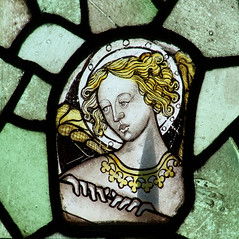 |
|
|
|

